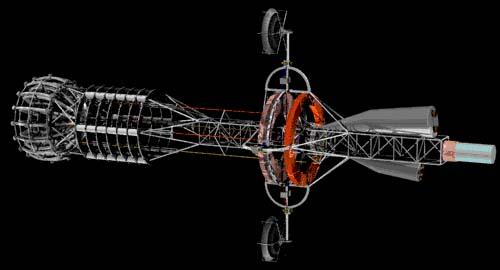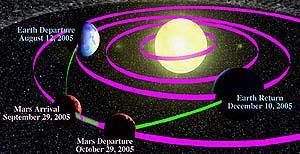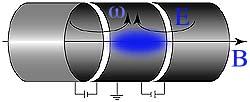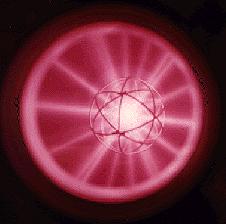 Space Science News home |
|
|
It's one of the most attractive words in science fiction literature and nearly as good a topic at parties as black holes. It might also be the fuel that powers spaceships to the planets and perhaps the stars, even if it's just used as a sophisticated book of matches. Right: Mars in 6 weeks? And back in a total of four months? That's the prediction of a design team working on antimatter rocket concepts at Pennsylvania State University. But first, you have to get the stuff - and store it. (PSU) Antimatter and more "conventional" nuclear fusion occupied the final day of the 10th annual Advanced Propulsion Research Workshop held Tuesday-Thursday at the University of Alabama in Huntsville by NASA, Marshall, the Jet Propulsion Laboratory, and the American Institute of Aeronautics and Astronautics. The popular belief is that an antimatter particle coming in contact with its matter counterpart yields energy. That's true for electrons and positrons (anti-electrons). They'll produce gamma rays at 511,000 electron volts. But heavier particles like protons and anti-protons are somewhat messier, making gamma rays and leaving a spray of secondary particles that eventually decay into neutrinos and low-energy gamma rays. And that is partly what Schmidt and others want in an antimatter engine. The gamma rays from a perfect reaction would escape immediately, unless the ship had thick shielding, and serve no purpose. But the charged debris from a proton/anti-proton annihilation can push a ship. "We want to get as close as possible to the initial annihilation event," Schmidt explained. What's important is intercepting some of the pions and other charged particles that are produced and using the energy to produce thrust." This is not your father's starship And what a reaction. Where the Space Shuttle Main Engine has a specific impulse, a measure of efficiency, of 455 seconds, and nuclear fission could reach 10,000 seconds, fusion could provide 60,000 to 100,000 seconds, and matter/antimatter annihilation up to 100,000 to 1,000,000 seconds. But first: Where do you get it? And how do you store the nuclear equivalent of the universal solvent?
Left: A schematic of the heart of a Penning trap where a cloud of antiprotons (the fuzzy bluish spot) is kept cold and quiet by liquid nitrogen and helium and a stable magnetic field. (PSU) While that's been done easily enough in small quantities, fueling a rocket will take much more. "We're building a Penning trap," Smith said, "one that will be lightweight and robust." When completed, it will weigh about 100 kg (220 lbs), much of it liquid nitrogen and helium to keep about a trillion anti-protons - far less than a nanogram - quiescent in a zone about 1 mm (1/25th inch) across. "How do you know that you have particles in the trap?" Smith asked. "They're odorless and colorless." However, they do have distinctive radio frequency signatures which Smith and his colleagues have been able to measure. They've also demonstrated that their trap design would hold a significant quantity for up to 5 days. |
 A Penn State artist's concept of n antimatter-powered Mars ship with equipment and crew landers at the right, and the engine, with magnetic nozzles, at left. |
|
"Our aim is to get up to a microgram of antiprotons," Smith said. "There are some interesting propulsion technologies that work at that level. We think we can do it." A trillion antiprotons is the maximum that can be stored under those conditions. More could be held if they were turned into anti-hydrogen, anti-protons plus positrons. A lot of bang for the buck "Right now, a lot of antiprotons are produced, but most are wasted," Gerrish said. Dr. Steven Howe of Synergistic Technologies in Los Alamos, N.M., explained that CERN is working towards producing anti-hydrogen as part of the Athena fundamental physics program to determine if antimatter indeed is indistinguishable from matter. Using the same Ioffe-Pritchard trap being developed at CERN, he expects that large quantities of anti-hydrogen atoms could be stored safely for long periods. At low temperatures, the wavelength of the atom is several times that of the material making up the container walls, so the atoms are reflected with little effort. "Our goal is to remove antimatter from the far-out realm of science fiction into the commercially exploitable realm for transportation and medical applications." Beyond the Enterprise - Fusion
power
"MTF tries to operate in an intermediate regime between the conventional magnetic fusion, and inertial confinement using a laser," Thio explained. The problem with conventional magnetic confinement is it operates at very low density. To achieve sufficient power, the fusion reactor must be large, which translates to a high cost. On the other hand, inertial confinement fusion uses a tiny plasma, 1,000 trillion times denser than in a magnetic confinement scheme. But that requires a driver - usually banks of intense, short-pulse lasers - that heat and compress the target in a short time. That also drives the cost up. "MTF tries to operate at not too low or too high a density," Thio explained, "and achieve a reasonable rate of fusion activity with a density 10,000 to 100,000 times higher than magnetic confinement, and 10,000 to 100,000 times lower than laser fusion." It's more economical and uses pulse-power drivers - powerful capacitor banks that drive electromagnetic implosion - that are available today at low cost. It does not have the implosion speed generated a laser beam, but a magnetic field confines the target plasma and insulates the inertial wall that implodes to cause the fusion. Can I get the compact model? "The mass is quite prohibitive," said Professor T. Kammash of the University of Michigan. "We want to make the physics work without using very large magnets." The mirror magnets for a fusion rocket would weigh about 401 tonnes (metric tons), about 16 times a single Space Shuttle payload. The heat radiators would add 240 tonnes. Kammash's students are experimenting with a droplet radiator design that, using liquid lithium as a coolant, could reduce the radiator mass to 57 tonnes. They recently flew a test model aboard NASA's KC-135 low-gravity aircraft to test a model radiator. A rotating magnetic field could induce a magnetic field and electrical currents, "a clever way of fooling the plasma" into behaving as if it was in a conventional magnetic mirror system. In turn, the mass of the spacecraft would come down from 720 to 230 tonnes, and the 44-meter (144-ft) long engine would have a specific impulse of 130,000 seconds. "It's quite impressive," Kammash said.
"This is a really neat concept, something you can literally put your hands around," said Dr. Jon Nadler of NPL Associates in Champaign, Ill. Under a Small Business Innovative Research grant from NASA/Marshall, he is working with the University of Illinois Urbana-Champaign to develop the idea that Farnsworth had in 1950: fusion in a small bottle. Right: Peering into the heart of a star. What looks like a 1950s model of an atom is a hollow cathode with a tiny plasma cloud contained inside an IEC fusion chamber small enough to sit atop a lab bench. (UIUC) "You can use the power [it would generate] to power electric propulsion, or use the plasma for thrust," Nadler explained. A star in a bottle "The SBIR funding has allowed us to make some historic advances," Nadler told the audience. Using a pulsed megawatt power supply, the IEC achieved its highest pulsed current yet - 17 amps at 40,000 volts. The IEC has also gone from producing one neutron (released by deuterium-deuterium fusion) in every 10 cycles to more than 100 neutrons per cycle. "I'm happy to report that everything is looking good for increased reactivity," he said. "And we haven't even stressed anything out yet." |
|
Left: A schematic of the energy well in the middle of a conventional magnetic field, and in the IEC chamber where fusion is induced. (UIUC) While true antimatter and true fusion propulsion will remain the "rockets of the future" for some time, a hybrid of the two might work in the near term. "It's a good short cut," Schmidt said of antimatter-catalyzed fusion. In this approach, a small quantity of antiprotons is beamed into a fusion target. The resulting matter-antimatter annihilation heats a target enough to cause thermonuclear fusion. Because of the energies and expense involved in producing antimatter, this method is not practical for power production on Earth. Overall, it is a net energy loser. Like all other forms of rocket propulsion, it's a sort of battery in which energy is expended to provide a large quantity in a tiny space, available on demand. But, it could yield a rocket with a specific impulse of 13,500 to 67,000 seconds (30-147 times better than the Shuttle Main Engine), depending on the scheme used. "Fusion missions would need just micrograms to reach the Oort cloud," the deep freeze of comets beyond the orbit of Pluto, Gerrish said. The antimatter load would cost about $60 million. Reaching the stars would require metric tons. |
|
MSFC Advanced Space Transportation Programs Office. Leftover Instruments Will Pave Way for New Propulsion Test (March 22, 1998) Well understood and well used scientific instruments will help verify a new instrument as they all fly on JAWSAT. Spacecraft may fly on "empty" (Jan. 22, 1999) Using a propulsive tether concept, spacecraft may be able to brake or boost their orbits without using onboard fuel. A NASA/Marshall project, named "ProSEDS," is slated to demonstrate braking, by accelerating an expended rocket toward re-entry. Lecture series to cover Physics for the Third Millennium (Feb. 2, 1998) Lectures on science in the next century will be held at Marshall Space Flight Center during February 9-12, 1998. Relativistic physics, and next generation propulsion techniques are among the topics. |
|
return to Space Science News Home
|
 April 12, 1999:
Antimatter.
April 12, 1999:
Antimatter. Anti-protons, explained Dr.
Gerald Smith of Pennsylvania State University, can be obtained
in modest quantities from high-energy accelerators slamming particles
into solid targets. The anti-protons are then collected and held
in a magnetic bottle.
Anti-protons, explained Dr.
Gerald Smith of Pennsylvania State University, can be obtained
in modest quantities from high-energy accelerators slamming particles
into solid targets. The anti-protons are then collected and held
in a magnetic bottle. One of the most intriguing possibilities
raised actually dates back to the 1950s and a concept developed
by Philo Farnsworth, who pioneered most of the fundamental technologies
for television in the 1920s and '30s.
One of the most intriguing possibilities
raised actually dates back to the 1950s and a concept developed
by Philo Farnsworth, who pioneered most of the fundamental technologies
for television in the 1920s and '30s. IEC fusion would
work best with a couple of unusual fusion cycles. One uses deuterium
(heavy hydrogen), easily refined from water on Earth, and helium
3 (helium lacking one neutron), quite rare here but possibly
abundant in lunar soil exposed to 4 billion years of solar wind.
The other fires protons into boron 11.
IEC fusion would
work best with a couple of unusual fusion cycles. One uses deuterium
(heavy hydrogen), easily refined from water on Earth, and helium
3 (helium lacking one neutron), quite rare here but possibly
abundant in lunar soil exposed to 4 billion years of solar wind.
The other fires protons into boron 11.